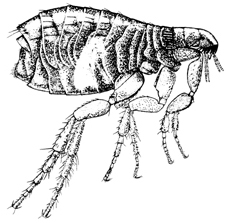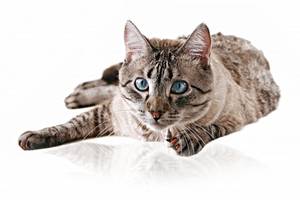What Are Dog Fleas and Cat Fleas?

Fleas are parasitic insects which are found all over the world. They feed on the blood of cats, dogs and other animals, including humans.
Fleas in cats and dogs are normally one of two species, either Ctenocephalides felis, the cat flea, or Ctenocephalides canis, the dog flea. However neither is host specific, and while the cat flea can infest dogs and vice versa, both can infest humans.
In fact, cat fleas are the most common fleas on both cats and dogs and have been known to infest more than 50 different animals, including raccoons, weasels, opossums and badgers. There are also human fleas, rat fleas (which were responsible for spreading the bubonic plague), rabbit fleas and many more.
Fleas go through four different life stages. The adult phase is the only stage seen on pets, while the other stages are found in the environment, usually in carpets or bedding and also in the yard.
Adults are usually between 1/16th to 1/8th of an inch long, red-brown in color and have three pairs of legs, the last pair being quite large and well-adapted for jumping. Fleas are wingless. Their bodies are flattened laterally (side to side) and covered with a hard, shiny coating, like an external skeleton, which helps them to move through an animal's fur.
|
Anti-flea treatments
|
Pet Shed's most popular solutions for ridding your pet of fleas
|
Fleas can jump up to seven inches (around 80mm) vertically and 13.5 inches (340mm) horizontally.1,2 They have piercing and sucking mouth parts which are specially designed for injecting into a host and sucking blood.
Eggs are laid on animals, but these generally drop off within a few hours (about 60 per cent drop off within two
hours, more than 70 per cent within eight hours1). Flea eggs resemble miniature chicken eggs, are
oval-shaped and white in color, but are quite shiny and just 0.5mm by 0.3mm in size.1
The larval stage of the flea looks like a spiny earthworm, about � inch long,� with no legs but boasting a big mouth. It starts out white, but as it feeds on adult feces (digested blood from its victim) and its gut is visible through the body wall, it quickly turns brown. Then it spins a whitish cocoon around itself and becomes a pupa.
Adult fleas are only the visible tip of the iceberg, making up just five per cent of the flea population. That is why flea control means not just killing the adults but controlling the invisible environmental stages as well.

- they are really itchy
- they can transmit flea tapeworms
- and, in young or small animals, they can suck a lot of blood and make the animals quite ill.
There are two ways that fleas cause itching. The first is the direct irritation of the flea bite, called flea dermatitis. The second, and more severe cause is an allergy to flea saliva, called flea allergy dermatitis or FAD.
Flea-ridden pets with no allergy will be a little itchy, with some tolerating fleas extremely well and not itching at all. However, animals with FAD will be very itchy, often severely self-traumatizing due to the intense irritation. with these animals, there is usually no relationship between the number of fleas and the severity of itching. Very sensitive animals are usually good at removing fleas. Cats tend to groom rather than scratch, so a constantly-cleaning cat may in fact be allergic to fleas.
|
"Adult fleas are only the visible tip of the iceberg, making up just five per cent of the flea population.�
|
Dogs with FAD will have a distribution of lesions and hair loss in a "Christmas tree" pattern over the rump and tail base. Flea dermatitis tends to be more widespread as small, red, solid skin lumps in areas where fleas are biting. On the other hand cats with a flea allergy suffer 'miliary dermatitis' which shows up as lumps and hair loss along their backline (like a racing stripe). This symptom can also occur in other skin diseases.
Skin inflammation and self-trauma caused by FAD can lead to infections, requiring treatment by antibiotics. Severe FAD often requires an initial phase of anti-inflammatory treatment to reduce the itching.
The tapeworm Dipylidium caninum is also transmitted by fleas. Dogs or cats contract the disease when they accidentally swallow a flea infected with immature stages of the tapeworm. Flea tapeworm infection only rarely causes severe symptoms in dogs or cats, with anal itchiness and 'scooting' (dragging the bottom on the ground in order to scratch it) being the most common sign in dogs.

In young pets with severe infestations, fleas can also cause anemia due to their diet of blood. Female fleas can consume about 15 times their own bodyweight in blood per day1, which for a female cat flea can mean some 13.6ml. Male fleas suck less blood and are less active than females.1 Both males and females increase their activity at dusk.
In summary, fleas are unlikely to cause fatal disease but they can cause discomfort and even trauma to pets and should be controlled. There are many easy-to-use, highly effective treatments available. The season in which fleas are most active varies from state to state. Ask your veterinarian about the flea season in your area and which products are best for your pets.
|
References
|
| 1. Kramer F, Mencke N (2001). Flea Biology and Control: the Biology of the Cat Flea,
Control and Prevention with Imidacloprid in Small Animals. Springer-Verlag Berlin. 2. Lyon, WF (1997). "Fleas�. Ohio State University Extension Fact Sheet. http://ohioline.osu.edu |